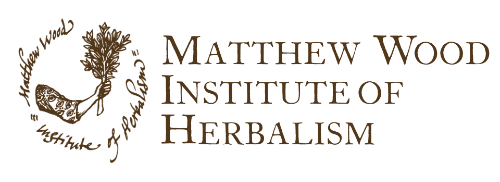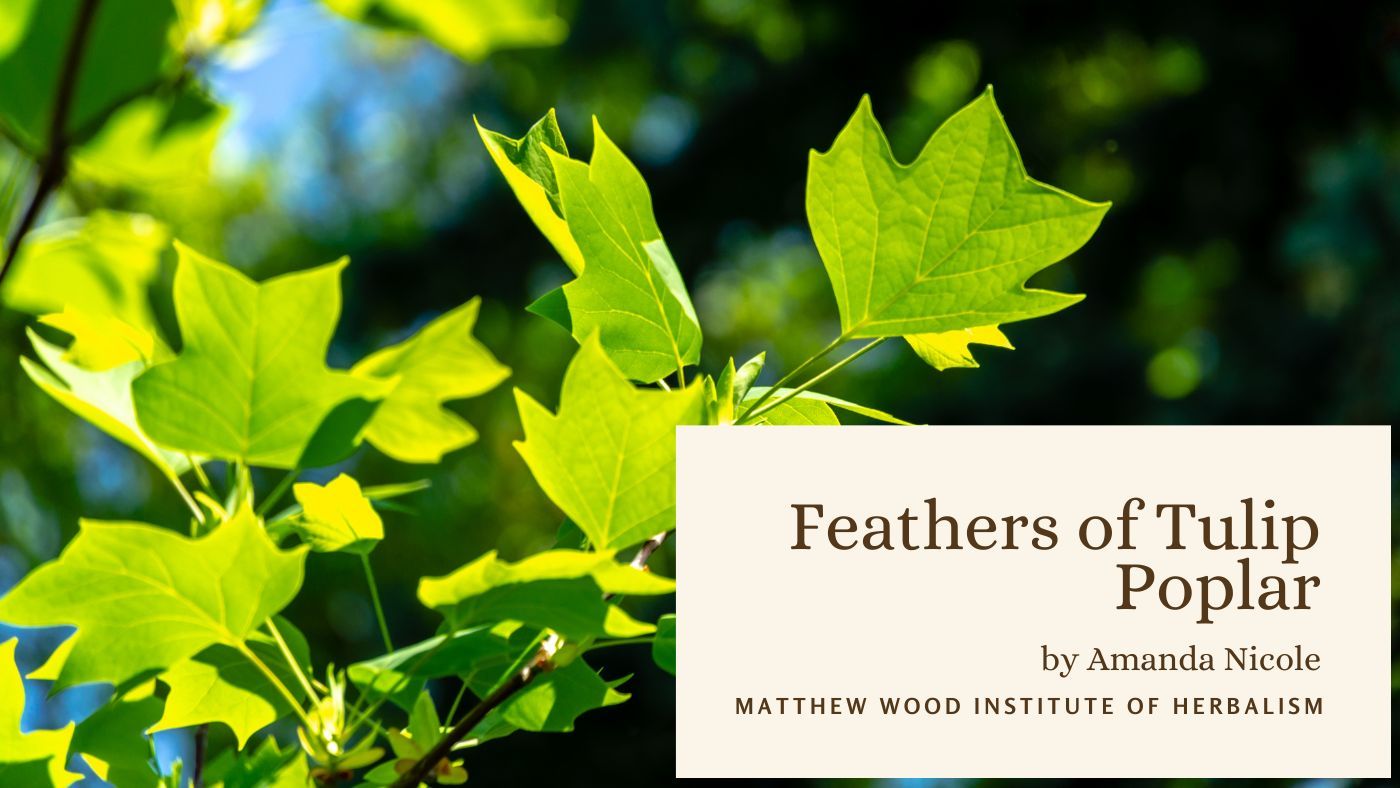Stone Medicine inspired my devotion to the Tulip Poplar tree.
As an enthusiastic, young herbalist, I desired to know the Latin name, constituents, and herbal actions of Every Green Thing. This desire to know was encouraged by the instruction of herbal elders who suggested I have a “working knowledge” of 100 herbs. I was (and remain) unsure of the elements necessary to constitute a “working knowledge” of mullein, chamomile, red raspberry, and blue vervain, but I endeavored to acquire it all the same.
The trouble was (and remains) that I am not one for small talk and chit chat. My soul desires conversations and relationships that nearly drown you in their depths and substance. I remember speaking with someone with whom I wanted to be friends, even soulmates. We moved in the same social circles and frequently came together at community dinners, seasonal festivals, and live music events. One summer evening, as we sat together on a white clover lawn and witnessed a summer sunset, I turned to them, and with all my heart, I confessed, “I want us to be friends!”
“We are friends,” they replied with a warm, inviting smile.
“No, we’re acquaintances,” I clarified. “I want us to be friends.”
And in time, we did. We spoke about what was actually on our minds and in our hearts rather than what sat politely on the surface, and we came to know one another beyond the general facts of eye color, vocation, and place of birth.
For me, this desire for deep connection and intimate knowing extends beyond human relationships and includes my relationships with the plants, so imagine my dissatisfaction in pursuing only a “working knowledge” of catnip, wild rose, and borage. I don’t simply want to know Viola odorata is commonly called sweet violet, acts as an expectorant and a lymphatic, and has an affinity for the throat and breasts! I desire to know sweet violet’s essence. What are its soul’s songs and stories?
Such intimacy, whether with a human or with a plant, is difficult to experience without a focused gaze and individualized attention given again and again and again. Intimacy takes time. It requires devoted intention.
For years, I shifted uncomfortably in the tension between the world of polite, small talk and the world of bare-my-soul conversation when it came to the plants. Welcome relief and a better way (for me) came when Sarah Thomas of Clarity Stone Medicine taught a class I attended. She enthusiastically suggested those present choose one stone -- just one stone -- to know intimately. Her eyes sparkled with wonder and possibility as she exclaimed, “What if you became the Garnet Stone Lady or the Rainbow Tourmaline Man! What if everyone who needed the medicine of Sodalite came to you because you knew everything there was to know about the stone? You knew Sodalite intimately -- like the back of your hand.
”With Sarah’s words came beautiful clarity. I would be a Liriodendress1. I would devote myself to knowing the Tulip Poplar tree.
Tulip Poplar holds the medicine of the Blue Heron. This graceful, avian medicine was first introduced to me by the beautiful artist and human, Rebekah Dawn of Mulberry Mudd. Long ago, she gave me a single blue heron feather accompanied by a slip of paper on which she had written: She Who Knows How to Stand Alone. At the time, the phrase meant nothing to me, but I came to know (as Rebekah knew I would) that Blue Heron medicine is about independence, stillness, and sovereignty.
Accompanying Blue Heron’s essence of elegant singularity is its ability to enable its human counterparts to be “wonderfully successful at being the traditional ‘jack of all trades’” as noted by Ted Andrews in his book, Animal Speak2. There is a phrase spoken by some: “jack of all trades, master of none”. Do you know it? The words perfectly describe my younger self. I played a little piano and wrote a little poetry. I knitted a little, quilted a little, baked a little, gardened a little. I sometimes hosted parties and once built a table. I could do anything at a skill level of fair to middling. Some things I could do surprisingly well. But I wasn’t the master of any particular skill. I dabbled. Dabbling is good. Dabbling is fun. But there’s something to be said for mastering a skill, for giving your time and attention to The One.
Blue Heron is the Bird of My Heart, and my bedroom is adorned with many of its blue-gray feathers. Some of the feathers I found while walking at the water’s edge. Some are gifts from friends. But the number of blue heron feathers gathered suddenly had competition when I stepped into my backyard one summer morning and began discovering blue jay feather after blue jay feather after blue jay feather. The grass was bejeweled with plumes of sapphire, tufts of onyx, and downy pearls. With elation, I gathered twenty-nine feathers! My heart was delighted with the gift and curious about the message.
I took Ted Andrews’ Animal Speak from the shelf and read that Blue Jay holds the medicine of mastery. There is dabbling. There is fair to middling. And then, there is the intentional development of talent that leads to mastery. Andrews writes, “The bright blue crest of the jay should always be a reminder that to wear the crown of true mastership requires dedication, responsibility, and committed development of all things in the physical and spiritual.
”On that jewel-feathered morning, this message resonated deeply with me. I had recently completed writing my second book, I AM the Tree and simultaneously decided to create Liriodendress Press, a publishing house where plants write books. I had completed creating Entosophy, a collection of philosophical dialogues with trees, and the interview with Japanese Cherry had been part of the Yale Graduate Conference on Religion and Ecology. With clarity and confidence, I had submitted a well-crafted application to a revered artist residency. All this and more had happened because I chose to devote myself to cultivating an intimate relationship with the Tulip Poplar tree.
My devotion to One True Thing has made a hundred thousand more Beautiful Things possible. I do have a “working knowledge” of 100 plants, but more importantly (for me), I have an intimate, substantive, cherished relationship with one wise and beautiful tree.
Here are (at least) 100 things I know about the Tulip Poplar tree:
dragon / angel / origin / wound / dagger / pierced / heart / blue / back door / vigilance / discernment / truth / harmony / harp strings / resonance / canary / memory / sing / golden / crown / regal / lion / peace / strength / tenderness / vulnerability / openness / slip on - slip off / shine / transparency / authenticity / impenetrability / humanity / welcoming / beckoning / dancing / singing / cheering / encouraging / The Parent Tree / mother wounds / mourning doves / peace / Divine Mother / Marlboro Man / wild mustang / freedom / captivity / The Jesus Tree / unforgivable / patience / process / wisdom / fox face / chickadee / diving timing / blue heron / standing alone / shapeshifting / stillness / elegance / grace / sovereignty / autonomy / confidence / standing tall / courage / angels / Heaven on Earth / conduit / cauldron / fire-tending / creation / rainbows / light / worship / I AM / solar plexus / portal / joy / bear claws / hands / baskets / canoes / keys / sacred vessel / chambers / four / world-facing
The list of words is inexhaustive, and each word has a story, an application, and is part of a wider web of connection, but perhaps these word-feathers enable you to catch a glimpse of the treasure that lies below Tulip Poplar’s golden surface.
I am Amanda Nicole, a Liriodendress. If you could devote yourself to One True Thing, what would it be?
You can learn more about topics covered in this blog by checking out classes co-taught by Amanda covering topics like Plant Attunement and Animal Medicine. You can also dive deeper into Tulip Poplar with her Appenticeship.
As an enthusiastic, young herbalist, I desired to know the Latin name, constituents, and herbal actions of Every Green Thing. This desire to know was encouraged by the instruction of herbal elders who suggested I have a “working knowledge” of 100 herbs. I was (and remain) unsure of the elements necessary to constitute a “working knowledge” of mullein, chamomile, red raspberry, and blue vervain, but I endeavored to acquire it all the same.
The trouble was (and remains) that I am not one for small talk and chit chat. My soul desires conversations and relationships that nearly drown you in their depths and substance. I remember speaking with someone with whom I wanted to be friends, even soulmates. We moved in the same social circles and frequently came together at community dinners, seasonal festivals, and live music events. One summer evening, as we sat together on a white clover lawn and witnessed a summer sunset, I turned to them, and with all my heart, I confessed, “I want us to be friends!”
“We are friends,” they replied with a warm, inviting smile.
“No, we’re acquaintances,” I clarified. “I want us to be friends.”
And in time, we did. We spoke about what was actually on our minds and in our hearts rather than what sat politely on the surface, and we came to know one another beyond the general facts of eye color, vocation, and place of birth.
For me, this desire for deep connection and intimate knowing extends beyond human relationships and includes my relationships with the plants, so imagine my dissatisfaction in pursuing only a “working knowledge” of catnip, wild rose, and borage. I don’t simply want to know Viola odorata is commonly called sweet violet, acts as an expectorant and a lymphatic, and has an affinity for the throat and breasts! I desire to know sweet violet’s essence. What are its soul’s songs and stories?
Such intimacy, whether with a human or with a plant, is difficult to experience without a focused gaze and individualized attention given again and again and again. Intimacy takes time. It requires devoted intention.
For years, I shifted uncomfortably in the tension between the world of polite, small talk and the world of bare-my-soul conversation when it came to the plants. Welcome relief and a better way (for me) came when Sarah Thomas of Clarity Stone Medicine taught a class I attended. She enthusiastically suggested those present choose one stone -- just one stone -- to know intimately. Her eyes sparkled with wonder and possibility as she exclaimed, “What if you became the Garnet Stone Lady or the Rainbow Tourmaline Man! What if everyone who needed the medicine of Sodalite came to you because you knew everything there was to know about the stone? You knew Sodalite intimately -- like the back of your hand.
”With Sarah’s words came beautiful clarity. I would be a Liriodendress1. I would devote myself to knowing the Tulip Poplar tree.
Tulip Poplar holds the medicine of the Blue Heron. This graceful, avian medicine was first introduced to me by the beautiful artist and human, Rebekah Dawn of Mulberry Mudd. Long ago, she gave me a single blue heron feather accompanied by a slip of paper on which she had written: She Who Knows How to Stand Alone. At the time, the phrase meant nothing to me, but I came to know (as Rebekah knew I would) that Blue Heron medicine is about independence, stillness, and sovereignty.
Accompanying Blue Heron’s essence of elegant singularity is its ability to enable its human counterparts to be “wonderfully successful at being the traditional ‘jack of all trades’” as noted by Ted Andrews in his book, Animal Speak2. There is a phrase spoken by some: “jack of all trades, master of none”. Do you know it? The words perfectly describe my younger self. I played a little piano and wrote a little poetry. I knitted a little, quilted a little, baked a little, gardened a little. I sometimes hosted parties and once built a table. I could do anything at a skill level of fair to middling. Some things I could do surprisingly well. But I wasn’t the master of any particular skill. I dabbled. Dabbling is good. Dabbling is fun. But there’s something to be said for mastering a skill, for giving your time and attention to The One.
Blue Heron is the Bird of My Heart, and my bedroom is adorned with many of its blue-gray feathers. Some of the feathers I found while walking at the water’s edge. Some are gifts from friends. But the number of blue heron feathers gathered suddenly had competition when I stepped into my backyard one summer morning and began discovering blue jay feather after blue jay feather after blue jay feather. The grass was bejeweled with plumes of sapphire, tufts of onyx, and downy pearls. With elation, I gathered twenty-nine feathers! My heart was delighted with the gift and curious about the message.
I took Ted Andrews’ Animal Speak from the shelf and read that Blue Jay holds the medicine of mastery. There is dabbling. There is fair to middling. And then, there is the intentional development of talent that leads to mastery. Andrews writes, “The bright blue crest of the jay should always be a reminder that to wear the crown of true mastership requires dedication, responsibility, and committed development of all things in the physical and spiritual.
”On that jewel-feathered morning, this message resonated deeply with me. I had recently completed writing my second book, I AM the Tree and simultaneously decided to create Liriodendress Press, a publishing house where plants write books. I had completed creating Entosophy, a collection of philosophical dialogues with trees, and the interview with Japanese Cherry had been part of the Yale Graduate Conference on Religion and Ecology. With clarity and confidence, I had submitted a well-crafted application to a revered artist residency. All this and more had happened because I chose to devote myself to cultivating an intimate relationship with the Tulip Poplar tree.
My devotion to One True Thing has made a hundred thousand more Beautiful Things possible. I do have a “working knowledge” of 100 plants, but more importantly (for me), I have an intimate, substantive, cherished relationship with one wise and beautiful tree.
Here are (at least) 100 things I know about the Tulip Poplar tree:
dragon / angel / origin / wound / dagger / pierced / heart / blue / back door / vigilance / discernment / truth / harmony / harp strings / resonance / canary / memory / sing / golden / crown / regal / lion / peace / strength / tenderness / vulnerability / openness / slip on - slip off / shine / transparency / authenticity / impenetrability / humanity / welcoming / beckoning / dancing / singing / cheering / encouraging / The Parent Tree / mother wounds / mourning doves / peace / Divine Mother / Marlboro Man / wild mustang / freedom / captivity / The Jesus Tree / unforgivable / patience / process / wisdom / fox face / chickadee / diving timing / blue heron / standing alone / shapeshifting / stillness / elegance / grace / sovereignty / autonomy / confidence / standing tall / courage / angels / Heaven on Earth / conduit / cauldron / fire-tending / creation / rainbows / light / worship / I AM / solar plexus / portal / joy / bear claws / hands / baskets / canoes / keys / sacred vessel / chambers / four / world-facing
The list of words is inexhaustive, and each word has a story, an application, and is part of a wider web of connection, but perhaps these word-feathers enable you to catch a glimpse of the treasure that lies below Tulip Poplar’s golden surface.
I am Amanda Nicole, a Liriodendress. If you could devote yourself to One True Thing, what would it be?
You can learn more about topics covered in this blog by checking out classes co-taught by Amanda covering topics like Plant Attunement and Animal Medicine. You can also dive deeper into Tulip Poplar with her Appenticeship.
1 A Liriodendress is a term I created in collaboration with my friend, Lance Howard. A Liriodendress mean: a daughter of the Tulip Poplar tree, or the embodied expression of Liriodendron tulipifera.
2 Andrews, Ted. Animal Speak: The Spiritual and Magical Powers of Creatures Great and Small. Woodbury, Minnesota: Llewellyn Publications. 2013.
3 ENTOSOPHY | alchemillas
**Disclaimer**
The information provided in this digital content is not medical advice, nor should it be taken or applied as a replacement for medical advice. Matthew Wood, the Matthew Wood Institute of Herbalism, ETS Productions, and their employees, guests, and affiliates assume no liability for the application of the information discussed.
3 ENTOSOPHY | alchemillas
**Disclaimer**
The information provided in this digital content is not medical advice, nor should it be taken or applied as a replacement for medical advice. Matthew Wood, the Matthew Wood Institute of Herbalism, ETS Productions, and their employees, guests, and affiliates assume no liability for the application of the information discussed.


